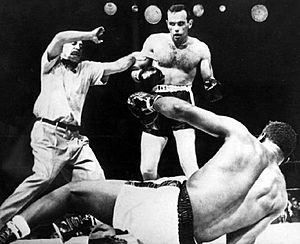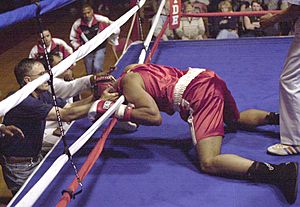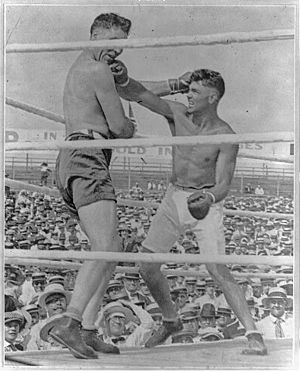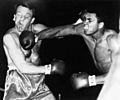Knockout facts for kids

A knockout (often called KO or K.O.) is a way to win a fight in many full-contact combat sports. These sports include boxing, kickboxing, Muay Thai, and mixed martial arts. It also happens in some karate and taekwondo matches. A knockout means a fighter can no longer continue the match after being hit.
Sometimes, a knockout happens when a fighter suddenly loses awareness because of a strong hit. Hits to the head, especially the jaw or temple, can cause this. Hits to the body, like a punch to the liver, can also cause a lot of pain. This pain can stop a fighter from continuing.
In boxing and kickboxing, a knockout is usually given when a fighter falls down. They must not be able to stand up within a certain time, usually ten seconds. This might be because they are very tired, in pain, confused, or have lost awareness. If a boxer is knocked down and cannot get up in ten seconds, their opponent wins by KO.
What is a Technical Knockout?
A technical knockout (TKO or T.K.O.) is also called a stoppage. It happens when the referee or a doctor decides a fighter cannot safely continue the match. This can happen for many reasons, and there is no ten-second count.
In many places, a TKO is called if a fighter is knocked down three times in one round. Other reasons for stopping a fight include serious cuts on the face. A fight can also be stopped if a fighter cannot defend themselves well after being knocked down.
In mixed martial arts (MMA) fights, the referee might call a TKO. This happens if a fighter is being hit repeatedly and cannot properly defend themselves. The referee stops the fight to protect the fighter.
How a Knockout Affects the Body
Experts are still learning exactly what causes a person to lose awareness during a knockout. Many believe it is linked to the brain being affected by a strong hit. This often happens when the head turns sharply from a punch. There are a few ways this can show up:
- Typical Knockout: The fighter loses awareness for three seconds or more. They might not remember what happened right before or during the knockout.
- Flash Knockout: The fighter loses awareness for a very short time, less than three seconds. They often still know what happened during the fight.
- Stunning or Dazing: The fighter stays standing but is very confused. They might have trouble with balance, seeing clearly, or hearing. Referees watch for this because it means the fighter is not safe to continue. They cannot defend themselves well.
A basic rule in boxing and other combat sports is to protect yourself. Fighters try to keep their hands up to cover their face and tuck their chin. This helps protect against hits to the head. However, a strong punch to the body, like to the solar plexus, can still be very effective.
When a fighter loses awareness from a strong hit, they are said to be knocked out or KO'd. If they fall down but do not lose awareness, they are knocked down. They are "down but not out."
Fighters are taught to defend against hits that can cause knockouts. This is important for their safety.
Images for kids
-
A heavy blow to the head is a frequent cause of a Knockout. Muhammad Ali delivers one to Brian London and retains his heavyweight championship by third-round KO on August 6, 1966.
See also
 In Spanish: Nocaut para niños
In Spanish: Nocaut para niños






